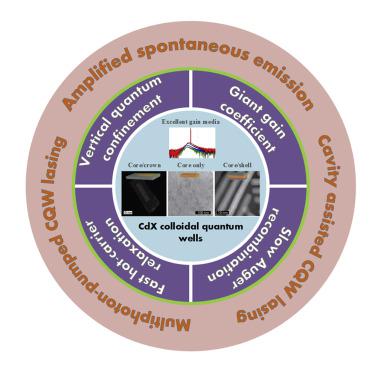Cell Reports Physical Science ( IF 7.9 ) Pub Date : 2021-01-20 , DOI: 10.1016/j.xcrp.2020.100308 Junhong Yu , Cuong Dang

|
Since the successful synthesis of two-dimensional colloidal systems in 2011, colloidal metal chalcogenide quantum wells (CQWs) have been a notable addition to the colloidal nanomaterial family. Besides inheriting advantages of colloidal nanocrystals, such as wide-band tunable emissions with high quantum yield and substrate-agnostic deposition, CQWs have exhibited unique characteristics of high-performance optical gain media, such as negligible inhomogeneous broadening in emission spectrum, a giant optical gain coefficient, no phonon bottleneck, and slow Auger recombination. Consequently, the demonstration of CQW-based laser applications has attracted scientific attention and research effort worldwide in recent years. In this review, we cover the recent advances of CQW-based lasers and categorize the progress according to the photon confinement and lasing mechanism: (1) amplified spontaneous emission in pristine CQWs, (2) CQW lasers with a cavity, and (3) multiphoton-pumped CQW lasers. Finally, the future of CQW-based lasers is discussed.
中文翻译:

激光应用的胶态金属硫族化物量子阱
自2011年成功合成二维胶体系统以来,胶体金属硫族化物量子阱(CQW)已成为胶体纳米材料家族的重要成员。除了继承胶体纳米晶体的优点(例如具有高量子产率的宽带可调发射和与基底无关的沉积)外,CQW还表现出高性能光学增益介质的独特特征,例如发射光谱中可忽略的不均匀展宽,巨大的光学增益系数,无声子瓶颈和缓慢的俄歇重组。因此,近年来,基于CQW的激光应用的演示吸引了全世界的科学关注和研究工作。在这篇评论中 我们介绍了基于CQW的激光器的最新进展,并根据光子限制和激射机理对进展进行了分类:(1)原始CQW中的放大自发发射;(2)带腔的CQW激光器;以及(3)多光子泵浦CQW激光。最后,讨论了基于CQW的激光器的未来。











































 京公网安备 11010802027423号
京公网安备 11010802027423号